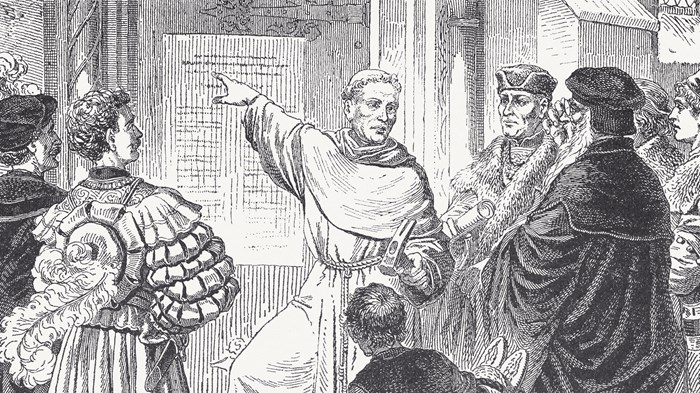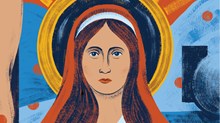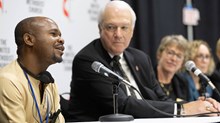
Sometime during October 31, 1517, the day before the Feast of All Saints, the 33-year-old Martin Luther posted theses on the door of the Castle Church in Wittenberg. The door functioned as a bulletin board for various announcements related to academic and church affairs. The theses were written in Latin and printed on a folio sheet by the printer John Gruenenberg, one of the many entrepreneurs in the new print medium first used in Germany about 1450. Luther was calling for a "disputation on the power and efficacy of indulgences out of love and zeal for truth and the desire to bring it to light." He did so as a faithful monk and priest who had been appointed professor of biblical theology at the University of Wittenberg, a small, virtually unknown institution in a small town.
Some copies of the theses were sent to friends and church officials, but the disputation never took place. Albert of Brandenburg, archbishop of Mainz, sent the theses to some theologians whose judgment moved him to send a copy to Rome and demand action against Luther. By the early months of 1518, the theses had been reprinted in many cities, and Luther's name had become associated with demands for radical change in the church. He had become front-page news.
The Issue of Indulgences
Why? Luther was calling for a debate on the most neuralgic issue of his time: the relationship between money and religion. "Indulgences" (from the Latin indulgentia—permit) had become the complex instruments for granting forgiveness of sins. The granting of forgiveness in the sacrament of penance was based on the "power of the keys" given to the apostles according to Matthew 16:18, and was used to discipline sinners. Penitent sinners were asked to show regret for their sins (contrition), confess them to a priest (confession), and do penitential work to atone for them (satisfaction).
Indulgences were issued by executive papal order and by written permission in various bishoprics, and they were meant to relax or commute the penitent sinner's work of satisfaction. By the late eleventh century it had become customary to issue indulgences to volunteers taking part in crusades to the Holy Land against the Muslims; all sins would be forgiven anyone participating in such a dangerous but holy enterprise. After 1300 a complete commutation of satisfaction ("plenary indulgence") was granted to all pilgrims visiting holy shrines in Rome during "jubilee years" (at first every hundred years, and, eventually, every twenty-five years).
Abuses soon abounded: "permits" were issued offering release from all temporal punishment—indeed, from punishment in purgatory—for a specific payment as determined by the church. Some popes pursued their "edifice complex" by collecting large sums through the sale of indulgences. Pope Julius II, for example, granted a "jubilee indulgence" in 1510, the proceeds of which were used to build the new basilica of St. Peter in Rome.
In 1515, Pope Leo X commissioned Albert of Brandenburg to use the Dominican order to sell St. Peter indulgences in his lands. Albert owed a large sum to Rome for having granted him a special dispensation to become the ecclesiastical prince ruling three territories (Mainz, Magdeburg, and Halberstadt). He borrowed the money from the Fugger bank in Augsburg, which engaged an experienced indulgences salesman, the Dominican John Tetzel, to run the indulgences traffic; one half of the proceeds went to Albert and the Fuggers, the other half to Rome. Tetzel's campaign gave rise to the famous jingle, "As soon as the coin in the coffer rings, a soul from purgatory springs."
The issue of indulgences had now become linked to the prevalent anxiety regarding death and the final judgment. This anxiety was fueled by a runaway credit system based on printed money and the new banking system.
The Message of Martin Luther
Luther attacked the abuse of indulgence sales in sermons, in counseling sessions, and, finally, in the Ninety-Five Theses, which rang out the revolutionary theme of the Reformation: "When our Lord and Master Jesus Christ said, 'Repent,' He willed the entire life of believers to be one of repentance" (Thesis 1).
By 1520, Luther announced that baptism is the only indulgence necessary for salvation. All of life is a "return to baptism" in the sense that one clings to the divine promise of salvation through faith in Jesus Christ alone, who by his life, death, and resurrection liberated humankind from all punishment for sin. One lives by trusting in Christ alone and thus becoming a Christ to the neighbor in need rather than by trying to pacify God.
It is this simple reaffirmation of the ancient Christian "good news," the gospel, that created in the church catholic the reform movement that attracted legions in Germany and other European territories. The movement was propelled by slogans stressing the essentials of Christianity: faith alone (soia fides), grace alone (sola gratia), Christ alone (solus Christus). Many joined because Luther criticized the papacy, which had claimed to have power over every soul. "Why does not the pope whose wealth today is greater than the wealth of the richest Crassus (a wealthy Roman nicknamed "Fats," who died in 53 B.C.) build this one basilica of St. Peter with his own money rather than with the money of poor believers?" (Thesis 87).
The Ninety-Five Theses were the straw that broke the Catholic camel's back. When Luther was asked later why he had done what he did, he answered, "I never wanted to do it, but was forced into it when I had to become a Doctor of Holy Scripture against my will." Though condemned by church and state, Luther survived the attempts to burn him as a heretic.
Hindsight suggests that Luther's theses planted the seeds of an ecumenical dialogue on what is essential for Christian unity, indeed for survival, in the interim between Christ's first and second coming. That dialogue will bear fruit as long as it wrestles, as Luther did, with the proper distinction between the power of the Word of God and the power of human sin.
Dr. Eric W. Gritsch is Maryland Synod Professor of Church History and director of the Institute for Luther Studies at Gettysburg Lutheran Seminary, Gettysburg, Pennsylvania.
Copyright © 1990 by the author or Christianity Today/Christian History magazine.
Click here for reprint information on Christian History.

Support Our Work
Subscribe to CT for less than $4.25/month




























